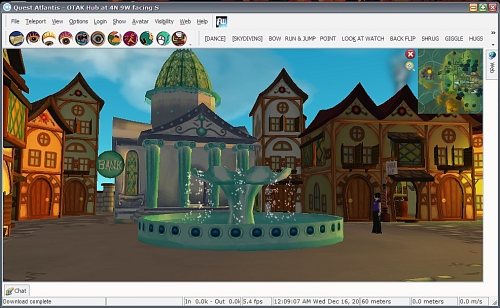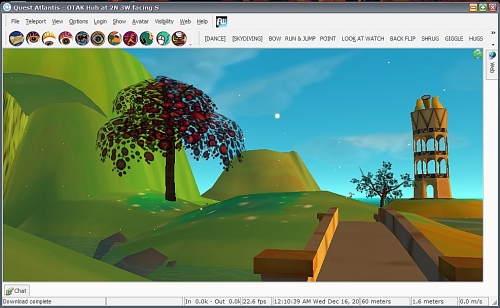Active Worlds (AW) is a 3D virtual reality platform. The “Active Worlds Browser” runs on Windows. Users assign themselves a unique name, log into the Active Worlds virtual world universe, and explore 3D virtual worlds and environments that other users have built. Users can chat with one another or build structures and areas from a selection of objects. AW allows users to own worlds and universes, and develop 3D content.

A Town Centre in Quest Atlantis - an established Activeworld
The browser [or client program] has web browsing capabilities, voice chat, and basic instant messaging. This integrated software can allow users to connect, explore, and gain a more in depth understanding of 3D. Corporate and educational clients of Active Worlds can make use of the interaction, communication, and media to provide functional environments suited for their objective. On May 30, 2006, version 4.1 was released to the general public.

Rolling Hills in Quest Atlantis - an established Activeworld
The program’s original goal was to be the 3D-equivalent of a 2D web browser (such as Internet Explorer or Firefox). Instead of creating a website, the user could construct an office, building, or area in which to display products or information.
Building allows users to create their own environment. For example, a user may search for or request an open plot of land and then construct the walls of the building with 4×4 meter wall pieces. The user may then decide to add windows, doors, furniture, landscaping, etc. Active Worlds supports objects stored as RenderWare script RWX (and the RW3+ binary equivalent DFF) and trueSpace objects COB, as well as DirectX “X” objects. The available objects are defined by the world owner.
Building in Active Worlds is done using the keyboard and mouse. All buildings are constructed of multiple copies of particular objects, arranged appropriately. In some respects, it is like building with virtual Lego blocks. Right-clicking an existing object will highlight it and open an “Object Properties” dialog box. Once an object is selected, it can be moved up/down, left/right, or forward/back. It can likewise be rotated on all axis, yaw (Y), pitch (Z) and roll (X). The object may be duplicated, and the new copy moved into a new position. The object may also be transformed into another object, by typing in the name of the desired object. So, for example, it is possible to transform a tree03.rwx into a rock10.rwx by selecting it and typing in “rock10.rwx” as the object name. The new rock can then be rotated 90 degrees around its X axis, moved 3.5 meters to the left, and sunk 1 meter into the ground. This is generally how builds grow to their incredible proportions, one object duplicated from another. [thankyou Wikipedia]
Recently v8.1.nnnn x64 was released of ActiveWorlds. It’s neat to see the old pics now but, wow is it different these days, as is to be expected I guess. One thing about AW is that while things are there from the beginning, once you venture away from those old locations you have a chance to see what’s been done as it’s continued to evolve and inspire.
One note to anyone wanting to reconnect with their original account though.. Best bet is to use the site’s support/help/Contact to send a message to AW re getting that old account to where you could log into it again. Unless, of course, you still know your password and can just log in once the current 64 bit client is installed.